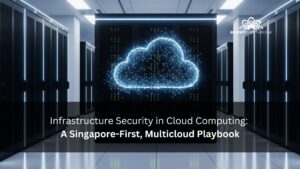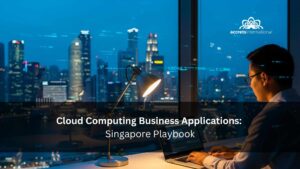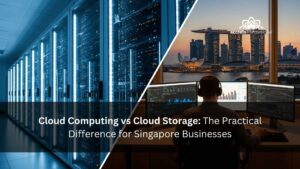This guide explains SaaS architecture in cloud computing and gives you a clear way to choose the right model for Singapore’s regulatory, cost, and latency realities. We will walk through a vendor-neutral chooser, three proven blueprints, and an operations playbook. If you want the concise answer first and then to learn together through deeper sections, keep reading until the end.
Table of Contents
ToggleTL;DR
- Choose outcomes first: compliance posture, data residency, per-tenant RPO/RTO, customization depth, and cost-per-tenant targets.
- Pick a stack pattern by combining runtime isolation (flat, namespace, node, cluster) with data tenancy (shared, sharded, database per tenant).
- Start lean and evolve safely: many teams begin with namespace plus sharded database, then graduate high-value tenants to database per tenant.
- Run it like a product: define tenant SLOs, implement noisy-neighbor controls, and attribute cost per tenant.
- Mind Singapore specifics: PDPA, sector rules like MAS TRM, and where data lives. Hybrid or local data centers may be the right move.
What Is SaaS Architecture (In Plain English)?
SaaS architecture is how you stitch tenant awareness through every layer: application runtime, data, identity, observability, delivery, and operations. It is more than hosting an app in the cloud. Multi-tenant concerns such as isolation, blast radius, and per-tenant customization shape everything from network policy to backup schedules. If your team is still calibrating infrastructure basics, a short refresher on the difference between compute and storage helps set context, as outlined in our overview of the cloud computing and cloud storage difference.
Start With Outcomes: A Singapore-First Decision Checklist
Answer these before picking a pattern:
- Regulatory posture: Are you handling PDPA-sensitive data or operating under MAS TRM? Banking and healthcare often require stronger isolation and auditability. For BFSI context, see cloud banking solutions for Singapore.
- Residency and sovereignty: Do some tenants require data to remain in Singapore or within government-approved boundaries? Public-sector teams sometimes evaluate Government Cloud Singapore.
- RPO and RTO per tenant: Will you need to restore a single tenant on demand, for example after accidental deletion or corruption?
- Customization depth: Do tenants need schema changes or only configuration-level differences?
- Unit economics: What target cost per tenant makes your pricing profitable, and how will you measure it?
The Unified Chooser: Runtime Isolation × Data Tenancy
Two dials determine most trade-offs.
Runtime isolation
- Flat: all tenants share pods and nodes, lowest cost, highest noisy-neighbor risk.
- Namespace: common sweet spot in Kubernetes, enables per-tenant quotas, policies, and RBAC.
- Node pinned: workloads isolated to node pools to limit blast radius and contention.
- Cluster per tenant: strongest isolation, highest cost and operational overhead.
Data tenancy
- Shared multi-tenant schema: fastest start, weakest per-tenant recovery and customization.
- Sharded multi-tenant: horizontal scale, shard-level restore, moderate complexity.
- Database per tenant: strong per-tenant backup and customization, higher management cost.
How to pick
- Choose runtime isolation to satisfy compliance and blast radius.
- Choose data tenancy to satisfy recovery granularity and customization.
- Check operational effort and cost per tenant.
- Set a migration path, for example free trials on shared, then sharded, then database per tenant for premium contracts.
For disaster recovery planning tuned to Singapore workloads, review patterns in cloud computing service providers in Singapore for backup and disaster recovery.
Blueprint 1: Fast and Lean Analytics SaaS (SMB or Startup)
When to choose
- Sub 50k SGD or USD MRR, high tenant count, low regulatory burden, speed and cost matter most.
Reference stack
- Runtime: namespace isolation with ResourceQuota and LimitRange, horizontal pod autoscaling on CPU or request rate.
- Data: sharded multi-tenant database with tenant_id in each row, shards aligned by region or usage.
- Operations: rate limiting and fair queuing to curb noisy neighbors, staged canaries per namespace.
Recovery and changes
- Restore per shard, collocate tenants by size and region to match RTO targets.
- Perform online schema changes and schedule shard rebalancing windows.
Why it works
- A balanced start that scales. You can later move a specific tenant to its own database without a full redesign. If elasticity is a priority, read the advantages of Infrastructure as a Service to understand what the platform provides natively versus what you need to implement.
Blueprint 2: Mid-Market B2B SaaS (Balanced Isolation and Cost)
When to choose
- You are closing enterprise deals with SLAs, need stronger per-tenant recovery, and moderate customizations.
Reference stack
- Runtime: namespace isolation with NetworkPolicy for tenant-scoped ingress and egress.
- Data: database per tenant in elastic pools or dedicated servers, automated provisioning pipeline.
- Security: per-tenant KMS keys, application RBAC tied to tenant_id, dedicated secrets management.
- Operations: connection routing by tenant, synthetic probes per tenant, UAT cloning by copying a tenant database into a test namespace.
Recovery and changes
- Treat per-tenant backup and restore as a first-class operation and offer on-demand tenant restore to enterprise customers.
- Use rolling schema migrations with compatibility windows.
Singapore tips
- Many firms pair this with a managed operations model to standardize onboarding and patching, such as managed IT services. Tighten posture with targeted reviews from cloud security consulting services in Southeast Asia.
Blueprint 3: Regulated Enterprise SaaS (Healthcare or Financial)
When to choose
- You handle PHI or PII or operate under MAS TRM. Auditors expect strong isolation, immutable logs, and evidence packs.
Reference stack
- Runtime: cluster per tenant for the highest tier or for regulated segments, private networking, strict NetworkPolicy and admission control.
- Data: database per tenant with per-tenant KMS keys, fine-grained roles, database activity monitoring.
- Operations: paved-road cluster builds, CIS-aligned baselines, auditable change management, dual-region disaster recovery.
Recovery and evidence
- Drill tenant-level failover and tabletop exercises quarterly and produce evidence such as RPO and RTO results and restore logs.
- Maintain a per-tenant runbook that documents encryption contexts, secrets rotation, and access approvals.
Facilities and residency
- Map architecture to the data center tier you rely on. Learn the expectations of tier-3 data centers, tier-4 data centers, and tier-5 data centers, and why Singapore is often the tier-2 Southeast Asia hub. For a broader security blueprint tailored to the region, see our Singapore-first multicloud security playbook.
Tenant SLOs and Noisy-Neighbor Control
- Propagate tenant_id across the stack from request to logs, metrics, traces, and cost tags.
- Define SLIs and SLOs per tenant for p95 latency, error rate, and availability. Publish a short SLO page in your tenant console.
- Enforce quotas and throttles with ResourceQuota, LimitRange, and rate limiting. Provide controlled bursts for legitimate spikes.
- Auto-scale deliberately, separating interactive and batch workloads to prevent stampedes.
- Roll workload forecasts into quarterly planning. Use the principles in IT infrastructure capacity planning to align budgets with growth.
Data Design and Per-Tenant Recovery Granularity
- Schemas: shared schema is fastest to start, database per tenant enables strong per-tenant restores and customizations at higher operational cost.
- Skew and indexing: anticipate uneven tenants and design indexes to protect hot accounts without harming shared capacity.
- Backups and PITR: document whether you can restore one tenant via row filters, export and import, or full database restore.
- Migrations: keep application versions tenant-aware with feature flags and data migrations staged by cohort.
- Disaster recovery playbooks: test cross-region replication and record actual RPO and RTO.
For planning support and validation of restore steps across all three blueprints, align with providers experienced in backup and disaster recovery.
Observability and FinOps: Knowing Your Cost Per Tenant
- Tagging and labels: use consistent tenant tags across compute, storage, network, and data services in AWS, Azure, and GCP.
- Dashboards: create per-tenant views for infrastructure cost, egress, storage growth, and cost per request by product area.
- Budget alarms: alert when cost per tenant deviates from the pricing model and adjust quotas or reserved capacity.
- Show the math: maintain a spreadsheet model for requests, storage, support load, and margins to align Product and Finance.
- Operating model: consider a cloud service broker approach for multi-provider purchasing or work with a managed cloud service provider for ongoing optimization.
Security and Compliance Baseline for Singapore
- Identity and access: authorize on tenant_id first, then user roles, and block cross-tenant data paths in both API and data layers.
- Secrets and cryptography: use per-tenant KMS keys for top tiers, prefer short-lived credentials, and maintain rotation runbooks.
- Network controls: default deny NetworkPolicy, workload identity, and private service endpoints.
- Audit and evidence: keep immutable logs with synchronized time sources and map controls to PDPA and MAS TRM.
- Residency: document physical data location for each tenant and how backup and analytics move data.
If you are evaluating a private deployment approach for stricter controls or residency, review what private cloud hosting services are and why businesses prefer them in 2025.
Build, Buy, or Hybrid for Singapore Delivery
- Public cloud alone is not mandatory. If tenants span mainland China or highly regulated ASEAN markets, hybrid can be pragmatic.
- Improve user experience with enterprise connectivity patterns and consider Teridion cross-border connection for China where legally permissible.
- If your SaaS integrates with Microsoft 365 or collaboration suites, align your roadmap with enterprise applications, including Office 365 and online collaboration tools.
- For modernization of on-prem estates or platform transitions, examine VMware alternatives and on-premise private cloud.
Migration Paths and Anti-Patterns
A safe evolution path
- Start with namespace plus sharded database.
- Graduate high-value tenants to database per tenant.
- Offer cluster per tenant only for strictly regulated segments.
Avoid these anti-patterns
- Over-isolation too early, which slows feature velocity and burns cash.
- Ignoring per-tenant restore, which makes audits and support difficult.
- Schema sprawl from uncontrolled per-tenant forks. Prefer feature flags and configuration first.
- Untracked egress, which causes surprise bills. Tag and alert early.
If you are re-platforming, clarify the modernization sequence with Infrastructure as Code vs Infrastructure as a Service.
The 12-Point SaaS Architecture Checklist
- Define regulated and non-regulated tenant tiers and data residency.
- Commit target RPO and RTO per tenant and verify in tests.
- Select runtime isolation and document blast radius.
- Select data tenancy and document restore granularity.
- Implement tenant_id propagation across logs, metrics, traces, and billing tags.
- Publish tenant SLOs for latency, errors, and uptime.
- Enforce per-tenant quotas, rate limits, and isolation policies.
- Codify backup and disaster recovery runbooks and rehearse per-tenant restores.
- Instrument cost per tenant dashboards and budget alarms.
- Map controls to PDPA and MAS TRM where applicable and generate evidence.
- Document the migration path from shared to sharded to database per tenant.
- Review quarterly for capacity, cost trends, and isolation posture.
Where Accrets Can Help
If you want to move faster with less risk, Accrets can operate as your managed cloud service provider, from enterprise cloud computing and cloud infrastructure as a service to managed backup services, IT-DR as a service, and turnkey managed IT services. Global teams setting up in Singapore often reference our guides on Singapore cloud VPS speed, cost, and compliance and business IT support in Singapore.If you would like a tailored architecture walkthrough, you can book a free consultation with an Accrets Cloud Expert for SaaS architecture by using the short form on our contact us page.
Dandy Pradana is an Digital Marketer and tech enthusiast focused on driving digital growth through smart infrastructure and automation. Aligned with Accrets’ mission, he bridges marketing strategy and cloud technology to help businesses scale securely and efficiently.




